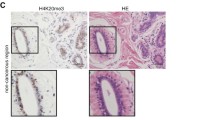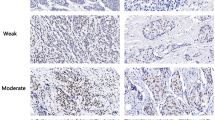Abstract
Acetylated H3 lysine 23 (H3K23ac) is a specific histone post-translational modification recognized by oncoprotein TRIM24. However, it is not clear whether H3K23ac levels are correlated with TRIM24 expression and what role H3K23ac may have in cancer. In this study, we collected breast carcinoma samples from 121 patients and conducted immunohistochemistry to determine the levels of TRIM24 and H3K23ac in breast cancer. Our results demonstrated that TRIM24 expression is positively correlated with H3K23ac levels, and high levels of both TRIM24 and H3K23ac predict shorter overall survival of breast cancer patients. We also showed that both TRIM24 and H3K23ac are higher in HER2-positive patients, and their levels were positively correlated with HER2 levels in breast cancer. Moreover, TRIM24 expression is associated with estrogen receptor (ER) and progesterone receptor (PR) statuses in both our cohort and The Cancer Genome Atlas (TCGA) breast carcinoma. In summary, our results revealed an important role of TRIM24 and H3K23ac in breast cancer and provided further evidence that TRIM24 small-molecule inhibitors may benefit ER- and PR-negative or HER2-positive breast cancer patients.




Similar content being viewed by others
References
Tsai WW, Wang Z, Yiu TT, Akdemir KC, Xia W, Winter S, et al. TRIM24 links a non-canonical histone signature to breast cancer. Nature. 2010;468(7326):927–32. doi:10.1038/nature09542.
Chambon M, Orsetti B, Berthe ML, Bascoul-Mollevi C, Rodriguez C, Duong V, et al. Prognostic significance of TRIM24/TIF-1alpha gene expression in breast cancer. Am J Pathol. 2011;178(4):1461–9. doi:10.1016/j.ajpath.2010.12.026.
Li H, Sun L, Tang Z, Fu L, Xu Y, Li Z, et al. Overexpression of TRIM24 correlates with tumor progression in non-small cell lung cancer. PLoS One. 2012;7(5):e37657. doi:10.1371/journal.pone.0037657.
Cui Z, Cao W, Li J, Song X, Mao L, Chen W. TRIM24 overexpression is common in locally advanced head and neck squamous cell carcinoma and correlates with aggressive malignant phenotypes. PLoS One. 2013;8(5):e63887. doi:10.1371/journal.pone.0063887.
Liu X, Huang Y, Yang D, Li X, Liang J, Lin L, et al. Overexpression of TRIM24 is associated with the onset and progress of human hepatocellular carcinoma. PLoS One. 2014;9(1):e85462. doi:10.1371/journal.pone.0085462.
Miao ZF, Wang ZN, Zhao TT, YY X, JH W, Liu XY, et al. TRIM24 is upregulated in human gastric cancer and promotes gastric cancer cell growth and chemoresistance. Virchows Arch. 2015;466(5):525–32. doi:10.1007/s00428-015-1737-4.
Xue D, Zhang X, Liu J, Li N, Liu C, Liu Y, et al. Clinical significance and biological roles of TRIM24 in human bladder carcinoma. Tumour Biol. 2015. doi:10.1007/s13277-015-3393-3.
Zhang LH, Yin AA, Cheng JX, Huang HY, Li XM, Zhang YQ, et al. TRIM24 promotes glioma progression and enhances chemoresistance through activation of the PI3K/Akt signaling pathway. Oncogene. 2015;34(5):600–10. doi:10.1038/onc.2013.593.
Pathiraja TN, Thakkar KN, Jiang S, Stratton S, Liu Z, Gagea M, et al. TRIM24 links glucose metabolism with transformation of human mammary epithelial cells. Oncogene. 2015;34(22):2836–45. doi:10.1038/onc.2014.220.
Jain AK, Allton K, Duncan AD, Barton MC. TRIM24 is a p53-induced E3-ubiquitin ligase that undergoes ATM-mediated phosphorylation and autodegradation during DNA damage. Mol Cell Biol. 2014;34(14):2695–709. doi:10.1128/MCB.01705-12.
Herquel B, Ouararhni K, Davidson I. The TIF1alpha-related TRIM cofactors couple chromatin modifications to transcriptional regulation, signaling and tumor suppression. Transcription. 2011;2(5):231–6. doi:10.4161/trns.2.5.17725.
Allton K, Jain AK, Herz HM, Tsai WW, Jung SY, Qin J, et al. TRIM24 targets endogenous p53 for degradation. Proc Natl Acad Sci U S A. 2009;106(28):11612–6. doi:10.1073/pnas.0813177106.
Yondola MA. Hearing P. The adenovirus E4 ORF3 protein binds and reorganizes the TRIM family member transcriptional intermediary factor 1 alpha. J Virol. 2007;81(8):4264–71. doi:10.1128/JVI.02629-06.
Peng H, Feldman I, Rauscher 3rd FJ. Hetero-oligomerization among the TIF family of RBCC/TRIM domain-containing nuclear cofactors: a potential mechanism for regulating the switch between coactivation and corepression. J Mol Biol. 2002;320(3):629–44. doi:10.1016/S0022-2836(02)00477-1.
Le Douarin B, Nielsen AL, Garnier JM, Ichinose H, Jeanmougin F, Losson R, et al. A possible involvement of TIF1 alpha and TIF1 beta in the epigenetic control of transcription by nuclear receptors. EMBO J. 1996;15(23):6701–15.
Le Douarin B, Zechel C, Garnier JM, Lutz Y, Tora L, Pierrat P, et al. The N-terminal part of TIF1, a putative mediator of the ligand-dependent activation function (AF-2) of nuclear receptors, is fused to B-raf in the oncogenic protein T18. EMBO J. 1995;14(9):2020–33.
Zennaro MC, Souque A, Viengchareun S, Poisson E, Lombes MA. New human MR splice variant is a ligand-independent transactivator modulating corticosteroid action. Mol Endocrinol. 2001;15(9):1586–98. doi:10.1210/mend.15.9.0689.
Kikuchi M, Okumura F, Tsukiyama T, Watanabe M, Miyajima N, Tanaka J, et al. TRIM24 mediates ligand-dependent activation of androgen receptor and is repressed by a bromodomain-containing protein, BRD7, in prostate cancer cells. Biochim Biophys Acta. 2009;1793(12):1828–36. doi:10.1016/j.bbamcr.2009.11.001.
Bodai L, Zsindely N, Gaspar R, Kristo I, Komonyi O, Boros IM. Ecdysone induced gene expression is associated with acetylation of histone H3 lysine 23 in Drosophila melanogaster. PLoS One. 2012;7(7):e40565. doi:10.1371/journal.pone.0040565.
Cerami E, Gao J, Dogrusoz U, Gross BE, Sumer SO, Aksoy BA, et al. The cBio cancer genomics portal: an open platform for exploring multidimensional cancer genomics data. Cancer Discov. 2012;2(5):401–4. doi:10.1158/2159-8290.CD-12-0095.
Gao J, Aksoy BA, Dogrusoz U, Dresdner G, Gross B, Sumer SO, et al. Integrative analysis of complex cancer genomics and clinical profiles using the cBioPortal. Sci Signal. 2013;6(269):pl1. doi:10.1126/scisignal.2004088.
Reiner A, Spona J, Reiner G, Schemper M, Kolb R, Kwasny W, et al. Estrogen receptor analysis on biopsies and fine-needle aspirates from human breast carcinoma. Correlation of biochemical and immunohistochemical methods using monoclonal antireceptor antibodies. Am J Pathol. 1986;125(3):443–9.
Li B, Dewey CNRSEM. Accurate transcript quantification from RNA-seq data with or without a reference genome. BMC Bioinformatics. 2011;12:323. doi:10.1186/1471-2105-12-323.
Khetchoumian K, Teletin M, Tisserand J, Mark M, Herquel B, Ignat M, et al. Loss of TRIM24 (TIF1alpha) gene function confers oncogenic activity to retinoic acid receptor alpha. Nat Genet. 2007;39(12):1500–6. doi:10.1038/ng.2007.15.
Baxter E, Windloch K, Gannon F, Lee JS. Epigenetic regulation in cancer progression. Cell Biosci. 2014;4:45. doi:10.1186/2045-3701-4-45.
Ferri E, Petosa C, McKenna CE. Bromodomains: structure, function and pharmacology of inhibition. Biochem Pharmacol. 2015. doi:10.1016/j.bcp.2015.12.005.
Juo YY, Gong XJ, Mishra A, Cui X, Baylin SB, Azad NS, et al. Epigenetic therapy for solid tumors: from bench science to clinical trials. Epigenomics. 2015;7(2):215–35. doi:10.2217/epi.14.73.
Bennett J, Fedorov O, Tallant C, Monteiro O, Meier J, Gamble V, et al. Discovery of a chemical tool inhibitor targeting the bromodomains of TRIM24 and BRPF. J Med Chem. 2015. doi:10.1021/acs.jmedchem.5b00458.
Palmer WS, Poncet-Montange G, Liu G, Petrocchi A, Reyna N, Subramanian G, et al. Structure-guided design of IACS-9571, a selective high-affinity dual TRIM24-BRPF1 bromodomain inhibitor. J Med Chem. 2015. doi:10.1021/acs.jmedchem.5b00405.
Gradishar WJ, Anderson BO, Balassanian R, Blair SL, Burstein HJ, Cyr A, et al. Breast cancer, version 1.2016. J Natl Compr Cancer Netw. 2015;13(12):1475–85.
Author information
Authors and Affiliations
Corresponding authors
Ethics declarations
Funding
This study was supported by National Natural Science Foundation of China (grant number 81472636) and Natural Science Foundation of Heilongjiang Province (grant number LC2015033).
Conflicts of interest
None.
Ethical approval
All procedures performed in this study were in accordance with the ethical standards of the Ethics Committee of Harbin Medical University and with the 1964 Helsinki declaration and its later amendments or comparable ethical standards. For this type of study, formal consent is not required.
Additional information
Li Ma and Lili Yuan contribute equally to this work.
Rights and permissions
About this article
Cite this article
Ma, L., Yuan, L., An, J. et al. Histone H3 lysine 23 acetylation is associated with oncogene TRIM24 expression and a poor prognosis in breast cancer. Tumor Biol. 37, 14803–14812 (2016). https://doi.org/10.1007/s13277-016-5344-z
Received:
Accepted:
Published:
Issue Date:
DOI: https://doi.org/10.1007/s13277-016-5344-z




